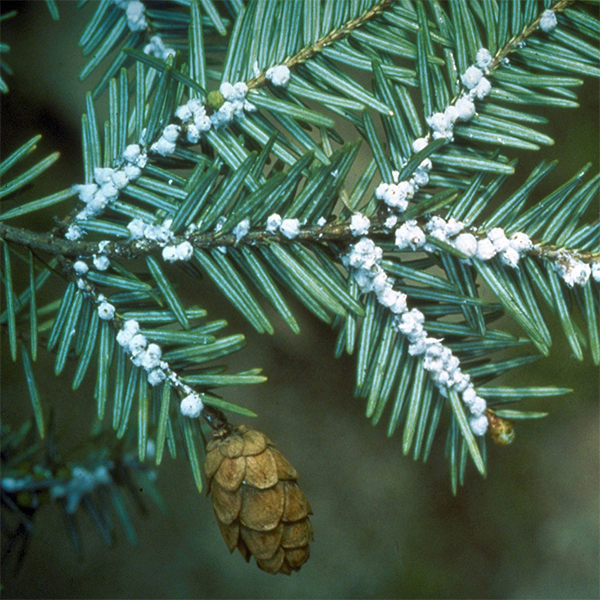
The Insect
The Hemlock Wooly Adelgid (Adelges tsugae Annand) is a tiny soft bodied insect similar to an aphid. There are two generations each year. Each reproductive adult lays from 50 to 300 eggs during April and May that hatch through June. Some develop into females that lay more eggs which hatch from June through mid-July. This second generation goes dormant until October, developing and feeding through the winter to reach maturity the next spring. The insect protects itself and its eggs in the white cottony fluff that is so distinctive in spring and fall.
Eggs hatch into nymphs that feed on the sap of Canadian hemlock (Tsuga canadensis), usually on the youngest twigs, killing existing needles and interfering with the production of new ones. Adult insects are spread by wind, birds, and animals; a certain number can also develop wings and fly to new sites.
Identification of Infected Hemlocks
Look for desiccated needles, turning gray-green and dropping off, and white cottony masses at the bases of the needles and on the undersides of twigs. UMass Extension describes their appearance as “small, white cotton balls lined up at the base of the needles.”
Control
Hemlock Wooly Adelgid IS controllable. Once the fluffy masses are spotted, quick treatment with oil sprays or insecticide or a combination of both is required. Oil sprays, both dormant and summer weight, kill by smothering. Dormant oil can be used in late winter and early spring, before new growth emerges to smother over-wintering generations, and followed by an insecticide spray in early June. Alternately, a summer weight oil can be used in early April and again in later June, or in September and early June; either spray regimen hits both major hatching cycles. Spraying must be thorough and throughout the entire plant to be effective. Note that oil sprays may damage hemlock during the growing season, especially in dry, hot weather. Systemic insecticides with the active ingredient imidacloprid (Merit) are also very effective. The insecticide is used as a soil drench above the root system or injected into the tree and is effective for about five months as long as the tree has a healthy sap flow.
Homeowners can control Wooly Adelgid on smaller hemlocks. Contact a reliable tree service for full-grown hemlocks.
Deep watering during drought and proper pruning of dead branches will help maintain the health of both un-infested and infested hemlocks.
Fertilizing an infested tree should be avoided since Wooly Adelgid seems to be attracted to new growth.
The western hemlock (Tsuga heterophylla) is highly resistant to the Wooly Adelgid but does not grow well outside of its native range of the northwestern USA. Some Asian hemlocks are showing resistance in early trials. A number of natural controls are being developed but are currently not available. Thus, chemical control is necessary. Because infestation can be fatal, annual preventive maintenance is recommended. Once adelgid is present, it is best to treat the tree annually.
Recommended reading:
University of Massachusetts Extension Hort Notes. Vol. 10, No. 12. August 2, 1999.
Website:
http://extension.umass.edu/landscape/fact-sheets/hemlock-woolly-adelgid









